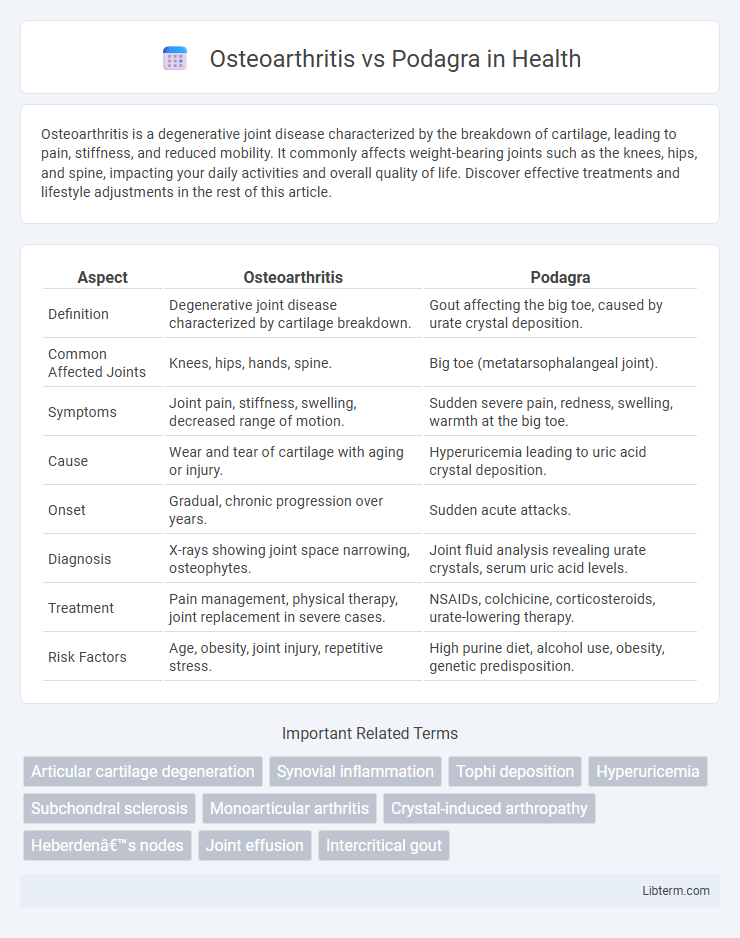Osteoarthritis is a degenerative joint disease characterized by the breakdown of cartilage, leading to pain, stiffness, and reduced mobility. It commonly affects weight-bearing joints such as the knees, hips, and spine, impacting your daily activities and overall quality of life. Discover effective treatments and lifestyle adjustments in the rest of this article.
Table of Comparison
| Aspect | Osteoarthritis | Podagra |
|---|---|---|
| Definition | Degenerative joint disease characterized by cartilage breakdown. | Gout affecting the big toe, caused by urate crystal deposition. |
| Common Affected Joints | Knees, hips, hands, spine. | Big toe (metatarsophalangeal joint). |
| Symptoms | Joint pain, stiffness, swelling, decreased range of motion. | Sudden severe pain, redness, swelling, warmth at the big toe. |
| Cause | Wear and tear of cartilage with aging or injury. | Hyperuricemia leading to uric acid crystal deposition. |
| Onset | Gradual, chronic progression over years. | Sudden acute attacks. |
| Diagnosis | X-rays showing joint space narrowing, osteophytes. | Joint fluid analysis revealing urate crystals, serum uric acid levels. |
| Treatment | Pain management, physical therapy, joint replacement in severe cases. | NSAIDs, colchicine, corticosteroids, urate-lowering therapy. |
| Risk Factors | Age, obesity, joint injury, repetitive stress. | High purine diet, alcohol use, obesity, genetic predisposition. |
Introduction to Osteoarthritis and Podagra
Osteoarthritis is a chronic joint condition characterized by the degeneration of cartilage, leading to pain, stiffness, and decreased mobility primarily in the knees, hips, and hands. Podagra specifically refers to gout affecting the big toe, caused by the deposition of uric acid crystals, resulting in sudden and severe joint inflammation. Understanding the distinct etiologies of osteoarthritis and podagra is essential for accurate diagnosis and targeted treatment strategies.
Defining Osteoarthritis: Causes and Risk Factors
Osteoarthritis is a degenerative joint disease characterized by the breakdown of cartilage, leading to pain, stiffness, and reduced mobility. Primary causes include aging, joint overuse, obesity, and genetic predisposition, while risk factors encompass previous joint injuries, repetitive stress on joints, and metabolic disorders. Unlike podagra, which specifically refers to gout affecting the big toe due to uric acid crystal deposition, osteoarthritis involves broader joint deterioration and cartilage degradation.
Understanding Podagra (Gout): Triggers and Contributors
Podagra is a form of gout that specifically affects the big toe, caused by uric acid crystal accumulation leading to intense joint inflammation and pain. Key triggers include high-purine foods such as red meat and seafood, alcohol consumption, dehydration, and certain medical conditions like hypertension or metabolic syndrome. Understanding these contributors is essential for managing podagra attacks and preventing recurrent episodes.
Key Differences Between Osteoarthritis and Podagra
Osteoarthritis primarily affects the cartilage and joints causing gradual wear and tear, while podagra refers specifically to gout affecting the big toe joint with sudden, intense inflammation. Osteoarthritis symptoms include joint pain, stiffness, and decreased mobility, whereas podagra presents with sharp pain, redness, and swelling due to uric acid crystal accumulation. Treatment for osteoarthritis focuses on pain management and joint protection, while podagra requires medications to reduce uric acid levels and inflammation.
Symptoms Comparison: Osteoarthritis vs Podagra
Osteoarthritis primarily causes joint pain, stiffness, and swelling, especially in weight-bearing joints like knees, hips, and hands, with symptoms gradually worsening over time. Podagra, a form of gout, manifests as sudden, intense pain, redness, and swelling in the big toe's metatarsophalangeal joint, often accompanied by warmth and tenderness during acute flare-ups. Unlike the chronic progression of osteoarthritis, podagra symptoms are episodic and linked to uric acid crystal deposits causing inflammation.
Diagnosis: How Osteoarthritis and Podagra Are Identified
Osteoarthritis is diagnosed through clinical evaluation, including joint pain assessment, range of motion tests, and characteristic radiographic findings such as joint space narrowing and osteophyte formation. Podagra, a manifestation of gout, is identified by acute onset of severe pain and swelling in the first metatarsophalangeal joint, confirmed by synovial fluid analysis showing monosodium urate crystals. Laboratory tests measuring serum uric acid levels support podagra diagnosis, while osteoarthritis diagnosis relies more on imaging and physical examination.
Treatment Options for Osteoarthritis
Osteoarthritis treatment primarily involves pain management through nonsteroidal anti-inflammatory drugs (NSAIDs), physical therapy, and lifestyle modifications such as weight loss and exercise to improve joint function. Advanced cases may require corticosteroid injections or surgical interventions like joint replacement to restore mobility. Unlike podagra, which is specifically managed with urate-lowering therapies targeting gout, osteoarthritis treatments focus on controlling inflammation and mechanical joint stress without addressing uric acid levels.
Management Strategies for Podagra
Podagra, a form of gout primarily affecting the big toe, requires management strategies centered on reducing uric acid levels through medications like allopurinol and lifestyle modifications including dietary adjustments to avoid purine-rich foods. Acute podagra attacks benefit from anti-inflammatory treatments such as NSAIDs, colchicine, or corticosteroids to alleviate pain and swelling. Long-term management involves patient education on maintaining hydration and limiting alcohol intake to prevent recurrent episodes and joint damage.
Lifestyle Modifications and Prevention Tips
Osteoarthritis management benefits significantly from lifestyle modifications, including maintaining a healthy weight, engaging in low-impact exercises such as swimming or cycling, and adopting joint-friendly postures to reduce stress on affected areas. Podagra, a form of gout primarily affecting the big toe, requires dietary adjustments like limiting purine-rich foods (red meat, shellfish), avoiding excessive alcohol, and staying well-hydrated to prevent urate crystal buildup. Both conditions emphasize the importance of regular physical activity, balanced nutrition, and avoiding joint strain to improve quality of life and reduce symptom severity.
When to Seek Medical Advice for Joint Pain
Seek medical advice for joint pain when experiencing persistent stiffness, swelling, or reduced range of motion, as these symptoms may indicate osteoarthritis or podagra. Immediate consultation is crucial if joint pain is accompanied by intense redness, warmth, or sudden onset of severe pain, characteristic of podagra, a form of gout affecting the big toe. Early diagnosis and treatment can prevent joint damage and improve quality of life by managing inflammation and pain effectively.
Osteoarthritis Infographic

 libterm.com
libterm.com